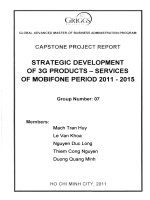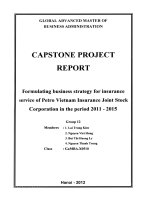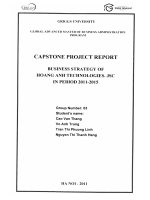Strategic development of 3G products - services of Mobifone period 2011 - 2015
Bạn đang xem bản rút gọn của tài liệu. Xem và tải ngay bản đầy đủ của tài liệu tại đây (1.72 MB, 88 trang )
Global Advanced Master of Business Administration
STRATEGIC DEVELOPMENT OF 3G
PRODUCTS - SERVICES OF MOBIFONE
PERIOD 2011 - 2015
Group 1: 1/ Thiem Cong Nguyen
2/ Nguyen Duc Long
3/ Le Van Khoa
4/ Duong Quang Minh
5 /Mach Tran Huy
HCM City– April /2013
C02.Strategic Management.Capstone Project Report. Group 7
1
TABLE OF CONTENT
TABLE OF CONTENT 1
LIST OF FIGURES 6
LIST OF TABLES 8
INTRODUCTION 9
CHAPTER I : THEORYTICAL BASIS OF BUSINESS STRATEGIC PLANNING11
1.1 Definition of strategy in business 11
1.1.1 Definition of strategy 11
1.1.2 Roles of strategy to the enterprise 11
1.2 Classification of business strategies 12
1.2.1 Types of typical strategies 12
1.2.1.1 Intergration strategy group 12
1.2.1.2 Intensive strategy group 12
1.2.1.3 Expansion strategy group 13
1.2.1.4 Other strategy group 13
1.2.2 Point of view of Michael Porter about typical strategies 13
1.3 Strategic development process 14
1.4. Analysis of external environment 15
1.4.1 Analysis of macro environment 15
1.4.2 Analysis of micro environment 17
1.5 Analysis of internal enterprise environment 18
1.6 SWOT analysis 19
1.7 Assessment matrixes to facilitate effective strategy selection 19
1.7.1 Process of forming an overall strategy 19
C02.Strategic Management.Capstone Project Report. Group 7
2
1.7.2 Sector analysis: External Factor Evaluation (EFE) 20
1.7.3 Sector analysis: Competitive image matrix 20
1.7.4 Analysis of company operation: Internal Factor Evaluation matrix (IFE) 20
1.7.5 Strength, weakness, opportunity, threat matrix (SWOT) 20
1.7.6 Strategy position and action evaluation Matrix (Space) 21
1.7.7 Internal - External Factor Matrix (IE) 21
1.7.8 QSPM matrix 21
CHAPTER II: THE CURRENT SITUATION OF PRODUCTION AND BUSINESS
OF MOBILE TELECOM SERVICES COMPANY 22
2.1 General introduction about the Mobile Telecom Services Company 22
2.2 History of formation and development 22
2.3 Vision, mission, key values, cultural values of Mobifone 23
2.4 Organizational structure of Company 25
2.5 Currently exploited products and services 26
2.5.1 Products 26
2.5.2 Services 27
2.6 Some noble rewards granted to MobiFone in the recent years 27
2.7 Production and business outputs of MobiFone in the recent years 28
2.7.1 Properties and capital in the recent years 28
2.7.2 Growth in subscribers 30
2.7.3 Revenue 30
2.7.4 Profit 32
2.7.5 Implementation of responsibilities to the State 33
2.8 Analysis internal environment of MobiFone 34
C02.Strategic Management.Capstone Project Report. Group 7
3
2.8.1 Strength 34
2.8.1.1 Brand 34
2.8.1.2 Market share 34
2.8.1.3 Financial resource 35
2.8.1.4 Human resource 35
2.8.1.5 Corporate culture 35
2.8.1.6 Infrastructure 35
2.8.1.7 Distribution channel 36
2.8.1.8 Products 36
2.8.1.9 Quality management system 37
2.8.2 Weaknesses 37
2.9 Analysis external environment of MobiFone 38
2.9.1 Analysis of macro environment 38
2.9.1.1 Domestic economic situation in 2010 38
2.9.1.2 Population, gender, age 38
2.9.1.3 Cultural – social situation 38
2.9.1.4 Scientific, technological situation 39
2.9.1.5 Globalization 39
2.9.1.6 Political, legal situation 39
2.9.2 Analysis of sector environment (Micro environment) 40
2.9.3 Analysis of competitors 43
2.10 Identification and analysis of limitations and weakness of 2G products –
services in the current situation 47
C02.Strategic Management.Capstone Project Report. Group 7
4
CHAPTER 3 DEVELOPMENT STRATEGY OF 3G PRODUCTS - SERVICES OF
MOBIFONE IN THE PERIOD OF 2011 – 2015 49
3.1 The development orientation of MobiFone Company in the next period 49
3.1.1 State orientation in development of Vietnam’s information and
communications technology 49
3.1.2 Some ferecast the market trend of mobile communication in the world and
Vietnam 49
3.1.3 Objectives of MobiFone in period of 2011 – 2015 50
3.2 Strategic selection matrix 52
3.2.1 External factor evaluation matrix (EFE) 52
3.2.2 Internal factor evaluation matrix (IFE) 54
3.2.3 Competitive image matrix 55
3.2.4 SWOT analysis matrix 56
3.2.5 Matrix on strategy position and action analysis (Space) 58
3.2.6 Matrix of internal – external factors (IE) 60
3.2.7 Strategic planning matrix with quantitative QSPM 61
3.3 Strategy implementation 66
3.3.1 Financial management 66
3.3.2 Human resource management 66
3.3.3 Differentiation Strategy 66
3.3.3.1 Methods to ensure quality of service 68
3.3.3.2 Customer Care 69
3.3.4 Market development Strategy 70
3.3.4.1 Network development 70
3.3.4.2 Market development plan 71
C02.Strategic Management.Capstone Project Report. Group 7
5
3.3.5 Penetration Strategy 71
3.3.5.1 Communication 71
3.3.5.2 Sales Organization 72
3.3.6 Products and services development strategy 75
3.3.6.1 The products and services to be provided 76
3.3.6.2 Main products and services for individual 77
3.3.6.3 Main products and services for business customers 78
3.3.6.4 Progress offers products and Services 79
3.3.7 Rates Strategy 80
3.3.8 Product promotion strategy 81
3.3.9 Low-cost strategy 81
RECOMMENDATIONS 83
CONCLUSION 84
REFERENCES 86
C02.Strategic Management.Capstone Project Report. Group 7
6
LIST OF FIGURES
Figure 1.1: A comprehensive model of strategy management 14
Figure 1.2: The factors affecting the macro environment 16
Figure 1.3: Model of five competition forces by M. Porter 17
Figure 1.4: Process of strategy formation 20
Figure 2.1: Organization structure of VMS 25
Figure 2.2: Growth in subcribers of MobiFone in the recent years 30
Figure 2.3: Revenue of MobiFone in the recent years 31
Figure 2.4: Weight ratio of revenue voice and services in the recent years 31
Figure 2.5: Weight ratio of revenue services in 2010 32
Figure 2.6: Profit of MobiFone in the recent years 32
Figure 2.7: Weight ratio of profit and revenue in the recent years 33
Figure 2.8: Implementation of responsibilities to the State of MobiFone in the recent
years 33
Figure 2.9: Market share of mobile operators in Vietnam 34
Figure 2.10: Market Share of mobile phone subscriber 44
Figure 2.11: ARPU comparison diagram by years (prepaid-postpaid services) 48
Figure 3.1: Number of 3G subscribers is expected 51
Figure 3.2: Market share 2G/3G subscribers of MobiFone is expected 51
Figure 3.3: Total 3G revenue is expected 52
Figure 3.4: The position of MobiFone in Space Matrix 59
Figure 3.5: Brand awareness in the market of mobile communication 67
Figure 3.6: Positioning the brand - 3G services of MobiFone 68
Figure 3.6: Network investment plan 70
C02.Strategic Management.Capstone Project Report. Group 7
7
Figure 3.7: Coverage by population plan 71
Figure 3.8: The 3G Difference for Service Distribution 72
Figure 3.9: The 3G Sales strategy and initiatives 73
Figure 3.10: Existing VMS Sales and Distribution Network 74
Figure 3.11: Future VMS Sales and Distribution Network 75
Figure 3.12: The 3G products and service for the individual customers 78
Figure 3.13: The 3G products and service for the business customers 79
Figure 3.14: Progress offers 3G products and Services 80
C02.Strategic Management.Capstone Project Report. Group 7
8
LIST OF TABLES
Table 2.1: Properties and capital in the recent years 28
Table 2.2: Properties and capital structure of MobiFone in the recent years 29
Table 2.3: General strengths and weaknesses of MobiFone 37
Table 2.4: General opportunities and threats of MobiFone 42
Table 2.5: Viettel Profile 45
Table 2.6: SWOT Analysis of Viettel 45
Table 2.7: Vinaphone Profile 46
Table 2.8: SWOT Analysis of Vinaphone 47
Table 3.1: EFE Matrix 53
Table 3.2: IFE Matrix 54
Table 3.3: Competitive image matrix of MobiFone 55
Table 3.4: SWOT matrix 56
Table 3.5: Space matrix 58
Table 3.6: IE Matrix 60
Table 3.7: Preliminary selection of the strategic plan 61
Table 3.8: QSPM matrix - group of Centralized Strategy 62
Table 3.9: QSPM matrix - group of intergrated strategy 63
Table 3.10: QSPM matrix - group of competitive strategy 64
Table 3.11: The norms for the quality measurement of the network 69
Table 3.12: The norms for customer 70
C02.Strategic Management.Capstone Project Report. Group 7
9
INTRODUCTION
Mobile telecommunications market is more and more developed, Mobile phone is not
only used to make and receive a call but also equipped with other functions such as
web sliding, film seeing, music download… To meet the higher demand of people,
scientists have continuously proposed the solutions to enhance the wireless data
transmission rate and 3G technology has been launched. 3G is the essential developing
trend of mobile telecommunications technology. Many countries in the world have
provided this product, service to customers and Vietnam is not an exemption.
Domestic customers started to use this service in the end of 2009.
Vietnam Mobile Telecom Services Company (VMS) is the first mobile phone operator
exploiting GSM 900/1800Mhz in Vietnam. VMS has provided the services since 1994
and operated with the brand name of MobiFone, marking the start of mobile
telecommunication market in Vietnam. The business operation of MobiFone is to
construction design, supply of mobile telecommunication services. Since 1994,
MobiFone has successfully exploited products, services based on 2G. Customers are
provided with various products, services and charge package with the best customer
services.
The mobile telecommunications market in Vietnam is an active, harshly competitive
market between service suppliers and restricted in developing potential. To help VMS
to rapidly provide varied 3G products, services to gain market share in Vietnam, we
carry our the theoretical research about product - service development strategy,
competition strategy, analysis of business and production situation of Company in
order to develop a development strategy for 3G products and services of MobiFone in
the period of 2011 - 2015.
- Research objective and application capacity:
The objective of this thesis is to develop the development strategy for 3G products
and services of MobiFone in the period of 2011-2015 expected to achieve the most
C02.Strategic Management.Capstone Project Report. Group 7
10
powerful development of 3G technologies, the broadband technology based on
mobile ground. Through this, we hope that Company will have more optimum
options in its overall development strategy in 2011-2015, aiming at 2020. We hope
that with the experience in 2G network operations, MobiFone will gain
opportunities to do business and exploit 3G products and services, bringing
benefits for Vietnamese customers and the society.
- Research method:
We make use of qualitative and quantitative method based on the market research
data, forecasts from specialists, customer feedback, or expected demand for mobile
service, subscriber growth rate, as well as the situation of 3G product and service
deployment of some countries in the region and in the world, the data is provided
by VMS. In addition, we also base on the data publicized on the websites of the
agencies or branches such as General Department of Statistics, Ministry of
Information and Communication, or specialized websites on information –
communication, especially in 3G sector.
Structure of the research: This thesis consists of 03 chapters:
- Chapter 1: Theoretical Basic of Business Strategic Planning;
- Chapter 2: The Current Situation of Production and Business of Vietnam Mobile
Telecom Services Company (VMS);
- Chapter 3: Development Strategy of 3G Products - Services of VMS in the Period
of 2011-2015.
C02.Strategic Management.Capstone Project Report. Group 7
11
CHAPTER I
THEORETICAL BASIS OF BUSINESS STRATEGIC
PLANNING
1.1 Definition of strategy in business
1.1.1 Definition of strategy
Some definitions of strategy:
According to Alfred Chander: “Strategy is the process of determining long-term basis
targets of company, selection of way or action direction and distribution of essential
resources to perform those targets";
According to James B. Quinn: " Strategy is a form or plan to coordinate main targets,
policies and procedures into an united form";
According to William J. Glueck: “Strategy is an united, comprehensive and
coordinative plan which is designed to ensure that basic targets of company will be
performed”.
There are many definitions about strategy. However, we can generally define strategy
as follows: “Strategy is a series of the complicated action plans to mobilize the
resource of an organization to achieve a specific objective”.
1.1.2 Roles of strategy to the enterprise
The development and management of strategy facilitate the enterprise in following
issues:
- To achieve the long-term and sustainable objectives of the enterprise.
- To grasp the market or market segment traded by the company or the business
strategy to be applied.
- How can the enterprise hold the upper hand compared with the rivals in the
market in term of specific customers?
- The resources to be used (people, skills, properties, finance, technological
know-how) to achieve such objectives.
C02.Strategic Management.Capstone Project Report. Group 7
12
- The externally implicit risks affecting the implementation of strategies
including environmental, political factors, natural resources…, and the risk
preventive measures.
- The values brought to the owner and the society by the enterprise as a member.
1.2 Classification of business strategies
1.2.1 Types of typical strategies
According to Fred R.David, it is possible to divide strategies into 14 types of typical
strategies and 04 groups as follows:
1.2.1.1 Integrated strategy group
- Forward intergration: this type is related to the increase of ownership or control to
distributors or retailers. An effective method to implement this combination
strategy is transfer of right. The enterprises can develop rapidly through transfer of
right since the cost and opportunity are divided to many individuals;
- Backward integrated: this type is related to the search for ownership or control of
company’s suppliers. This strategy is especially suitable when the current
suppliers of the company are not reliable, expensive or fail to satisfy the
requirements of the Company;
- Horizontal integrated: this strategy is related to the discovery of ownership or
control to rivals. The merging, acquisition helps to improve the effectiveness of
the scope, and increase the exchange of resources and capacity.
1.2.1.2 Intensive strategy group
- Market Penetration refers to the search for additional market shares for current
products and services in the existing markets through marketing efforts. Market
penetration includes the increase of sales staff, advertisement cost, production
products or advertisement efforts;
- Market Development refers to the launching of existing products and services to
new sectors;
C02.Strategic Management.Capstone Project Report. Group 7
13
- Product Development refers to the increase of turnover by the improvement or
adjustment of existing products or services. Product development requires high
research and development cost.
1.2.1.3 Expansion strategy group
- Diversification of concentric activities means the addition of new but interacted
products or services;
- Diversification of activities in horizontal manner means the addition of new
products and services those have not relation for existing customers;
- Diversification of activities in combined manner means the addition of new
products or services without interaction.
1.2.1.4 Other strategy group
- Joint venture: two or more companies form an independent company for
cooperative purposes;
- Operation contraction refers to the consolidation through cost and property cut to
save the dropping revenue and profit;
- Activity cut-down refers to the selling of a branch or a part of the company;
- Liquidation means the selling of all the properties, partially, with tangible values;
- Combination pursues two or many strategies at the same time.
1.2.2 Point of view of Michael Porter about typical strategies
According to Porter, typical strategies enable company to get competitive advantages
from three different aspects:
- Cost strategy refers to the manufacturing of standardized products at low unit price
for price-sensitive customers;
- Differentiation refers to the strategy aiming at the production of service products
considered as specific in the sector for customers those are not sensitive to the
price;
- Focus on the main point refers to the production of products and services to meet
the demands of small groups of customers;
C02.Strategic Management.Capstone Project Report. Group 7
14
One reason for pursuing forward strategy, backward strategy or horizontal strategy is
to gain the benefits of price orientation.
Product development is a typical strategy with many advantages for the product
distinction (differentiation strategy). The successful product distinction means the
higher product flexibility, greater combination ability, lower cost, improved services,
fewer maintenance, more comfortability, or more specific traits.
The strategies such as market penetration, market development provide much
advantage.
1.3 Strategic development process
Figure 1.1: A comprehensive model of strategy management
(Source: [3,page.27])
Feedback information
Thiết lập mục
tiêu dài hạn
Lựa chọn các
chiến lược để
theo đuổi
Xác định
nhiệm vụ
mục tiêu và
chiến lược
hiện tại
Thực hiện
việc kiểm soát
bên ngoài để
xác định các
cơ hội và đe
dọa chủ yếu
Xét lại
mục tiêu
kinh doanh
Thực hiện
kiểm soát nội
bộ để nhận
diện những
điểm mạnh
yếu
Phân phối
các nguồn
tài nguyên
Đo lường
và đánh giá
thành tích
Thiết lập
những mục
tiêu hàng năm
Đề ra các
chính sách
Thông tin phản hồi
Feedback
Establish
long-term
objectives
Select the
strategies to
pursue
Identify the
target tasks
and current
strategies
Implement the
external
control to
identify the
main
opportunities
and threats
Review
business
objective
Implement
internal
control to
identify the
strength and
weakness
Distribute
natural
resources
Measure
and
evaluate
achievemen
ts
Establish
annual
objectives
Propose
policies
Feedback
Strategy
development
Strategy
implementatio
n
Strategy
evaluation
C02.Strategic Management.Capstone Project Report. Group 7
15
The strategy management is comprised of 03 stages including strategy establishment,
strategy implementation and strategy evaluation:
- Strategy establishment is a process of establishing the business tasks; carrying out
the research to determine the internal and external limitations; setting long-term
objectives; and selecting alternative strategies. Sometimes, this process is called as
“strategy planning” including 03 basic activities: research, intuition harmony, and
decision-making;
- Strategy implementation or action period of the strategy management aims at
mobilizing managers and staff to implement the proposed objectives. The three
basic activities of strategy implementation involve establishment of annual
objectives, policy introduction and distribution of natural resources. This period is
considered as the most difficult period in the strategy management;
- Strategy evaluation is the last period of strategy management. All the strategies
depend on the future changes due to regular changes of internal and external
factors. The three basic activities of this phase involve (1) review of factors as
basis for current strategy, (2) achievement measurement, and (3) implementation
of adjustment activities.
1.4. Analysis of external environment
1.4.1 Analysis of macro environment
The external environment refers to all the external factors those can not be controlled
by managers but impose significant influence on the growth and profitability of each
company. Analysis of the external environment is involved in the analysis of the
macro environment and the sector environment (micro). The analysis of these factors
helps the enterprise to identify its position and the features of the environment, the
current age; and to learn the impact of the external environment to the enterprise so
that it can make decision suitable with the strategy planning.
The changes in the macro environment may impose direct impact on any force in the
sector, resulting in the change of relative power between the forces and the
C02.Strategic Management.Capstone Project Report. Group 7
16
attractiveness of the sector. The macro environment is comprised of 6 segments
including economy, social culture, demography, political law, technology and global.
Figure 1.2: The factors affecting the macro environment
Economic factors
Economic factors refer to the growth rate, the stability of the economy, the purchasing
power, the stability of price, money, inflation, exchange rate… those have influence on
the business and production of the enterprise.
Cultural and social factors
Social factors also attracts the interest of enterprises in the market research. Social
factors will divide the community into different customer groups of different features,
psychology, income…
- The average expectation of life, health situation, nutrition, feeding;
- Average income, income distribution;
- Living style, knowledge, aesthetic opinion, living psychology;
- Living condition.
Demographic factors
C02.Strategic Management.Capstone Project Report. Group 7
17
Demographic factors refer to population, age structure, geographical distribution,
ethnic community and income distribution.
Political, legal factor : The factors of influence are:
- Political stabilization;
- Tax policy;
- Related laws and commercial policies.
Technological factor
Technological factors are comprised of new production methods, new materials,
production devices, know-how, inventions, application software…
Factor of globalization
The integration and globalization require the enterprises to consider the international
factor in the process of planning so that they can obtain long-term strategies with high
opportunity of integration and expansion in term of geography and politics.
1.4.2 Analysis of micro environment
According to Michael Porter, there are five competition orienting forces within the
sector including: (1) New entrant; (2) Rivalry between the current firms; (3)
Bargaining power of buyers; (4) Bargaining power of sellers; (5) Threats of substitute
products or services.
Figure 1.3: Model of five competition forces by M. Porter
(Source: [4,page.37])
C02.Strategic Management.Capstone Project Report. Group 7
18
Competition pressure of supplier
- The quantity and scale of suppliers;
- Product substituting ability of suppliers;
- Information about suppliers.
Competition pressure of customers
Customers are classified into 2 groups including retail customers and distributors.
These both groups can create pressures to enterprises in term of product price, quality
as well as the enclosed services. They can control the competition in the sector by
deciding to buy the goods and services.
Competition pressure of implicit rivals
According to M-Porter, the implicit rivals of the enterprises have not appeared in the
sector market but can influence the sector in the future.
Competition pressure of substitute products
Substitute products and services refer to those can satisfy the similar demand of
customers for products and services in the sector.
Competition pressure within sector
The enterprises in the sector will compete directly with each other to create the
pressure on the sector and form the competition intensity. Following factors of the
sector will increase pressure on the rivals:
- Sector situation;
- Sector structure.
1.5 Analysis of internal enterprise environment
To exist and grow, all organizations must carry out the activities including
management, finance, accounting, production, business, research & development,
marketing… and have information system. In each operation sector, each organization
has its own strength and weakness.
Analysis of internal environment is an important and essential part of strategy
management. If the analysis of internal environment is not carried out well without the
right identification of strength, weakness; perfect strategy can not be established.
C02.Strategic Management.Capstone Project Report. Group 7
19
1.6 SWOT analysis
SWOT analysis refers to the analysis of external environmental factors faced by the
enterprises (opportunities and threats) as well as the factors belonging to the
enterprise’s internal environment (strength and weakness).
The enterprise identifies the opportunities and threats through data analysis of the
changes in the environment including economic, financial, political, legal, social
enviroment and competiton in the markets in which the enterprise is currently
operating or plans to enter.
Regarding the analysis of the enterprise’s internal environment, the strength in
enterprise organizing may be skills, resource, and advantages over the rivals (key
capacity of the enterprises). The weak aspects of the enterprise is expressed through
the shortcomings or weakness or poor skills, resources and the factors reducing the
competitiveness of the enterprise.
1.7 Assessment matrixes to facilitate effective strategy selection
1.7.1 Process of forming an overall strategy
According to Fred R. David, the strategy formation includes 3 stages including
penetration, combination and decision.
C02.Strategic Management.Capstone Project Report. Group 7
20
Stage 1: Penetration
External Factor
Evaluation (EFE)
Competitive image matrix
External Factor Evaluation
matrix (IFE)
Stage 2: Combination
Strength-
Opportunity- Threat
(SWOT)
Strategic point
and action
evaluation
(SPACE)
Boston
consulting
group (BCG)
Internal –
External
matrix (IE)
Grand strategy
matrix
Stage 3: Decision
Quantitative strategy planning matrix (QSPM)
Figure 1.4: Process of strategy formation
(Source: [3,page.260])
1.7.2 Sector analysis: External Factor Evaluation (EFE)
External Factor Evaluation enables strategists to summarize and evaluate economic,
cultural, social, demographic, geological, political, government, technological and
competing information.
1.7.3 Sector analysis: Competitive image matrix
Competitive image matrix helps company to identify the rivals, their strengths, and
weakness to help Company to develop proper business strategy.
1.7.4 Analysis of company operation: Internal Factor Evaluation matrix (IFE)
This matrix summarizes and evaluates the important strength and weak point effecting
the functional business departments and the production business of the enterprise.
1.7.5 Strength, weakness, opportunity, threat matrix (SWOT)
SWOT matrix is an important combined tool for the development of 04 types of
strategy as follows:
- Strength - opportunity strategy (SO): Use strengths to make use of opportunities;
- Strength – Threat (ST): Use strengths to avoid threats;
C02.Strategic Management.Capstone Project Report. Group 7
21
- Weakness - Opportunity (WO): Overcome weakness by taking advantage of
opportunities;
- Weakness – Threat (WT): Minimize weakness and avoid threats.
1.7.6 Strategy position and action evaluation Matrix (Space)
Strategy position and action evaluation matrix is used to evaluate the operation of the
business, and determine the location of the business in the market. The axis of this
matrix represent the two aspects within the organization: financial strength (FS) and
competitive advantage (CA) and two outside business aspects: environmental stability
(ES) and strength of the sector (IS).
1.7.7 Internal - External Factor Matrix (IE)
IE matrix is based on the two main aspects including the total scores of importance of
IFE on X axis and the total score of importance of EFE on Y axis.
IE matrix may be divided into 3 big sectors, each of which is comprised of various
strategies.
1.7.8 QSPM matrix
QSPM (Quantitative Strategic Planning Matrix) aims at the evaluation and ranking of
strategic options so that we can have basis to select the best strategy for the enterprise.
This matrix makes good use of information, data from the matrixes mentioned above
including EFE matrix, Competitive image matrix, IFE matrix, SWOT matrix, Space
matrix, IE matrix, and the grand strategy matrix. This is the tool to carry out objective
evaluation of alternative strategies, which is firstly based on the grand internal and
external factors to success.
C02.Strategic Management.Capstone Project Report. Group 7
22
CHAPTER II
THE CURRENT SITUATION OF PRODUCTION AND BUSINESS OF
MOBILE TELECOM SERVICES COMPANY
2.1 General introduction about the Mobile Telecom Services Company
- Official name: VIETNAM MOBILE TELECOM SERVICES COMPANY
- International transaction name: VIETNAM MOBILE TELECOM SERVICES CO
(VMS)
- Headquarter: MobiFone Building, Lot VP1, Yen Hoa Urban Area, Cau Giay,
Hanoi
- Website:
- Establishment date: 16/4/1993
- Logo and trade mark:
2.2 History of formation and development
Vietnam Mobile Telecom Services Company - VMS, a state-owned company under
Vietnam Posts and Telecommunications Corporation, was founded in April 16th 1993.
VMS has become the first GMS 900/1800Mhz mobile telecommunication services
provider in the brand name of MobiFone, marking the beginning of the mobile
telecommunication industry in Vietnam.
MobiFone specializes in building, developing network and providing mobile telecom
services
- 1993: Foundation of Vietnam Mobile Telecom Services Company (VMS);
- 1994: Foundation of the Mobile Telecom Services Center I & II with the
headquarter located in Hanoi and Ho Chi Minh City;
- 1995: Foundation of the Mobile Telecom Services Center III with the headquarter
located in Da Nang city;
C02.Strategic Management.Capstone Project Report. Group 7
23
- 2006: Foundation of the Mobile Telecom Services Center IV located in Can Tho
City;
- 2008: Foundation of the Mobile Telecom Services Center V. Foundation of Added
Value Center. By April 2008, Mobifone is holding the No. 1 position in term of
mobile subscription market in Vietnam;
- 2009: Receipt of the most excellent mobile network in 2008 granted by Ministry of
Information and Communication; official supply of 3G service; foundation of
Billing Center;
- 7/2010: Conversion into a one member limited company owned by the State;
- 12/2010: Foundation of Mobile Telecom Service Center VI located in Bien Hoa
City.
2.3 Vision, mission, key values, cultural values of Mobifone
- Vision
Become the most powerful and trustful of relevant parties in telecommunication
sector in Vietnam and the world.
- Mission
+ All the most advanced telecom technologies will be applied for customer
demand;
+ Continual creativity aims at providing new added values to customers;
+ All information is shared in the most explicit manner;
+ VMS will be the trustful place for interest sharing for staff, customers,
shareholders and community.
- Key value of the Company
+ Transparency
Transparency is expressed through the awareness to action of each individual in
the Company. Transparent management, cooperation, responsibility and right
are always ensured.
+ Consensus
C02.Strategic Management.Capstone Project Report. Group 7
24
Consensus and strong attachment are highly appreciated in a friendly and
sharing working environment to enable MobiFone to become the most
powerful and trustful partner of the relevant parties in the Telecommunication
sector of Vietnam and the world.
+ Prestige
We are proud of the outstanding of the top trade mark in mobile telecom sector
in Vietnam. Customers are always cared, served and provided with various
options. The closeness and determination to make the difference helps
MobiFone to take a special position in the heart of customers.
+ Creativity
MobiFone does not satisfy with what it is having but always strives, learn,
creates and innovates to better meet the increasing demand and continuous
changes of the market.
+ Responsibility
The development attached to the social responsibility is tradition of MobiFone.
We commit to provide the society with the advanced mobile products and
services; to share the responsibilities with the society for a sustainable future.
- Cultural standard of MobiFone:
High-quality service
Politeness and joy
Transparency and cooperativeness
Rapidness and accuracy
Dedication and creativity









